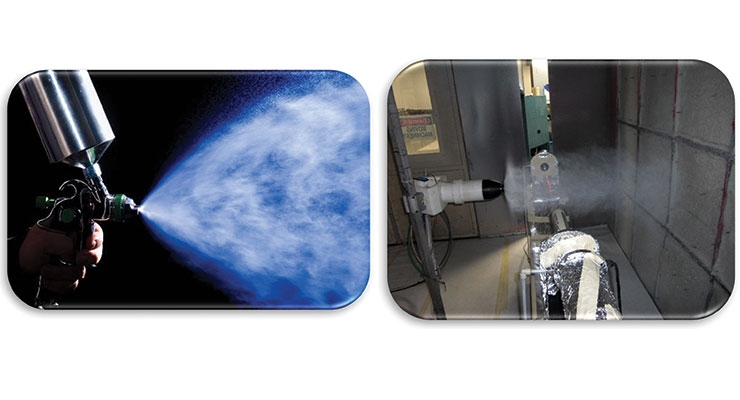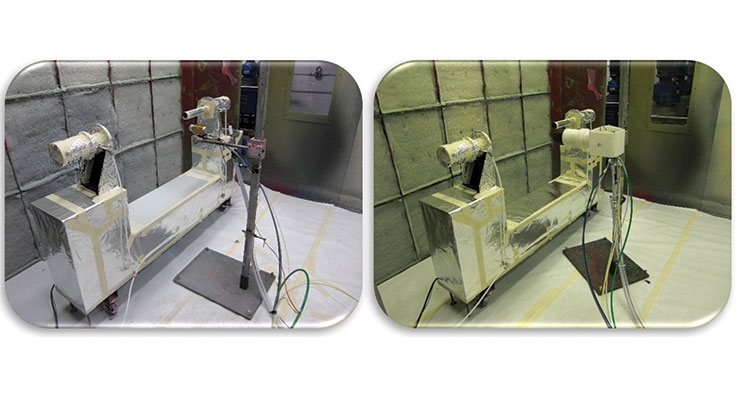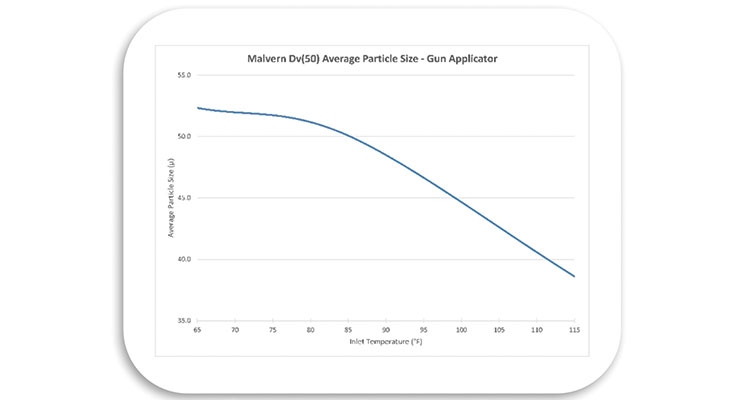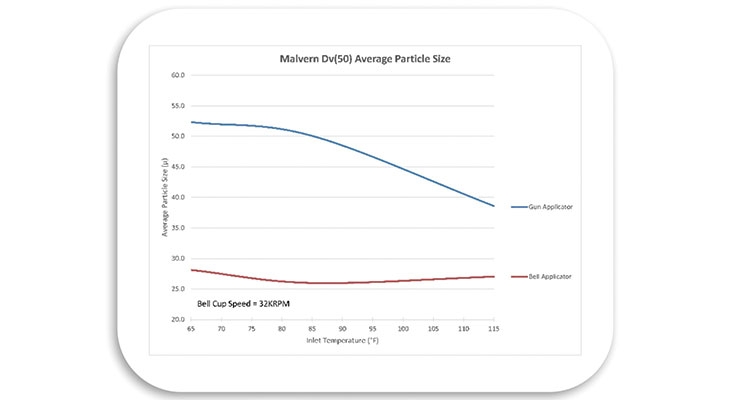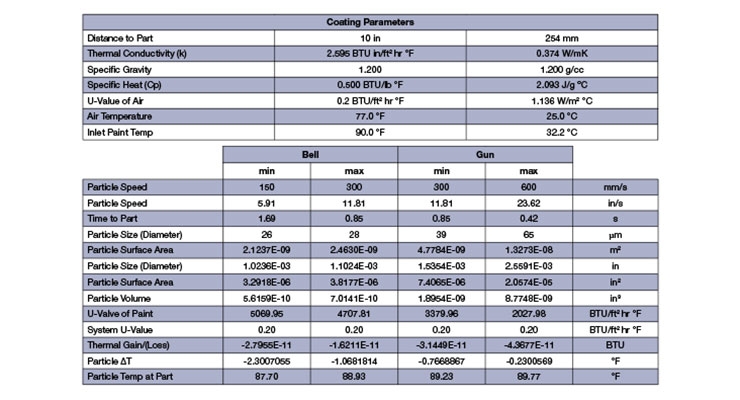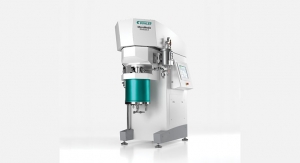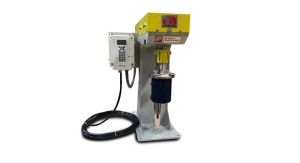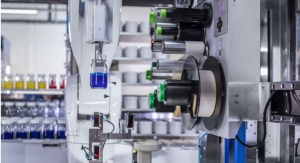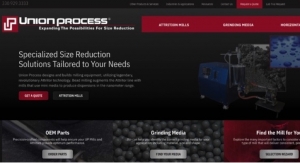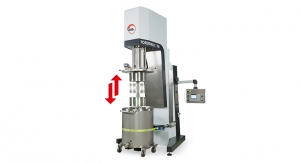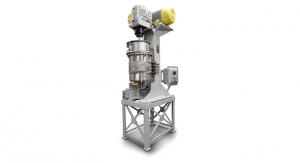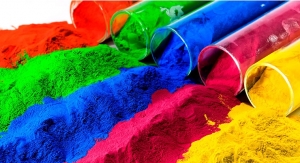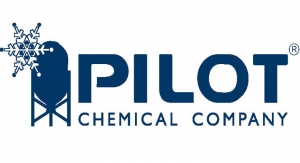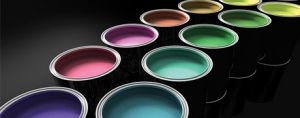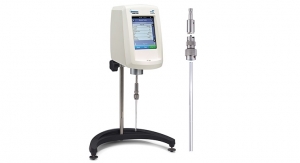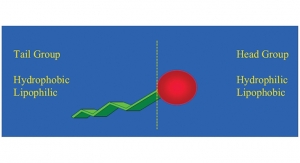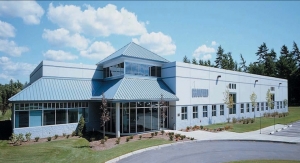Michael R. Bonner, Vice President of Engineering & Technology, Saint Clair Systems, Washington, MI10.03.18
Abstract
If you believe that the selection of guns or bells for your coating application technology is based solely on atomization and transfer efficiency, you are only considering half of the picture. In this paper, we examine some little-known facts about guns and bells — things that your supplier never told you — and how these “secrets” affect the application of waterborne, solventborne, and UV-cure coatings, specifically with regard to surface finish. We distill these factors into practical guidelines to help you select the best applicator for your project so that you may more than double your chances to obtain your desired finish results with high first-pass yields and minimal finish-related rejects.
Introduction
The goal of any finishing operation is to apply a consistent and contiguous coating to the subject part. The coating serves many purposes:
1. Beautification to improve the aesthetic appearance of the part.
2. Protection against such things as scratches, corrosion, UV damage, etc.
3. Improved performance in the part’s final application. This can include increasing resistance to moisture, reducing aerodynamic drag (i.e., automobiles, airplanes, rockets), hydraulic drag (i.e., boats, ships, torpedoes), and a host of others.
There are many ways to apply coatings including dipping, brushing, rolling, flow coating, etc., but in this discussion, we are going to focus on spray operations.
In a spray operation, the coating is atomized into a pattern of droplets and applied to the surface of the part, where the droplets rejoin one another and flow out to form a film. The primary devices used to perform this atomization are guns and bells.
Comparing Guns and Bells
Similarities
Because they both do the same job, it is easy to understand that there are many similarities between guns and bells. Both atomize the coating into a cloud, creating a fan pattern that can spread out over the surface of the target part (Figure 1).
Both use compressed air to “shape” the fan pattern. Both can be used in electrostatic applications, where the paint particles are charged at a high voltage and the part is grounded to create an “attraction” between the paint droplets and the part. This helps to reduce overspray, get more of the paint on the part, and increase transfer efficiency.
Differences
While both create a fan pattern, it is obvious from Figure 1 that the patterns created can be very different. This is due, in part, to the differences in the way that the atomized cloud is created. We will explore that in detail in the next section.
Bells are larger and heavier than guns. This makes guns more suitable for manual spray applications by providing an operator greater control with less stress and fatigue. Bells are generally limited to robotic, reciprocator, or otherwise automated applications.
While any paint applicator is susceptible to maintenance and cleaning issues, bells are more complex, with lots of moving parts. In general, bells require more maintenance than guns.
Bells are generally used with lower viscosity fluids supplied at lower pressure, whereby guns may be better suited for higher viscosity, higher pressure applications.
Atomization
Fundamentals
In short, atomization is the result of applying shear, which tears the fluid stream into a cloud of small particles.
On the bell, the rotating cup generates shear in the fluid by adding force perpendicular to the direction of the fluid stream as it reaches the edge of the cup. The size of the particles is primarily determined by (a) the design of the cup itself, (b) the flow rate of the coating, which determines the rate at which fluid is delivered to the edge of the cup, and (c) the speed of rotation, which determines the speed of the cup edge relative to the fluid stream. As a result, most of the energy imparted to the particle is perpendicular to the bell and parallel to the part. Without some means of directing the cloud, it would simply hover adjacent to the part with very little fluid actually reaching the surface. Shaping air is then used not only to “shape” the fan pattern but also to direct it toward the part.
Guns, on the other hand, generate shear by reducing the diameter of the fluid stream, which increases its velocity, and then forcing it through a small orifice. This breaks the fluid stream into small particles creating the atomized cloud. Atomization is controlled by the size and shape of the orifice, and the flow rate of fluid through it, which is generally a function of the characteristics (size and shape) of the flow path, the viscosity of fluid, and the pressure behind it. The fan pattern is also both shaped, and directed, by the shaping air, but because the fluid stream is already moving toward the part at a high velocity when it is atomized, guns create particles with a higher velocity toward the part than do bells.
Quantifying the Differences
So how do these differences in atomization affect our day-to-day coating operation? This was put to the test at Carlisle Finishing Technologies’ lab in Toledo, OH, where we used their Malvern particle size analyzer to measure the distribution of particle sizes in the atomized cloud for a typical gun and bell as shown in Figure 2.
To maintain consistency, both gun and bell tests were performed using an HCNTX 2K clearcoat. Ratio, fluid flow, and atomizing and shaping air were all held constant with a Ransberg RCS system. Ambient conditions were simulated with a Saint Clair Systems paint temperature control system implemented with a re-corable coax hose as the heat exchanger. This configuration allowed accurate control of temperature all the way to the point of dispense in controlled, repeatable steps. This system is shown in Figure 3.
Gun Testing
Though sequence was not important due to the accuracy of control with this test system, the first tests were performed with the gun setup as shown in Figure 2. With all other parameters held constant by the RCS system, the temperature was varied in controlled increments from 65 °F – 115 °F (18 °C – 46 °C) for the expressed purpose of varying clearcoat viscosity. At each step, the resulting Dv(50) particle size in the atomized cloud was measured using the Malvern analyzer.
The results are summarized and shown in Figure 4. Here we can see that, with all other variables held constant, the average particle size for the gun applicator varied from 52.3 µ at 65 °F (18 °C) to just 38.6 µ at 115 °F (46 °C).
Based on the discussion of gun atomization above, it is reasonable to conclude that the change in atomization is directly related to the change in clearcoat viscosity resulting from the change in temperature.
In addition to variations in particle size, the change in viscosity will affect particle recombination and flow out on the surface of the part. This will have a direct impact on the quality of the finish with regard to film build, gloss, orange peel, etc.
Bell Testing
Next, the gun was replaced with a bell in the setup shown in Figures 2 and 3. The cup speed was set at 32,000 RPM, and, as with the gun, all other parameters were held constant by the RCS system. The temperature was again varied in controlled increments from 65 °F – 115 °F (18 °C – 46 °C) for the expressed purpose of varying clearcoat viscosity and, at each step, the resulting Dv(50) particle size in the atomized cloud was measured using the Malvern analyzer.
The results are summarized and shown in Figure 5. Here we can see that, with all other variables held constant, the average particle size for the bell applicator held constant at ~27 µ independent of the changes in temperature.
Based on the discussion of atomization above, it is also reasonable to conclude that bell atomization is not affected by the change in clearcoat viscosity resulting from the change in temperature.
This theory was confirmed by increasing the cup speed from 32,000 RPM to 60,000 RPM at the median temperature of 85 °F. This shifted the average particle size from ~27 µ to ~16 µ.
Because these are both plotted on a 20 µ particle size scale and a 65 °F to 115 °F temperature scale, they can be combined on the same graph, as shown in Figure 6. This allows us to readily compare the atomization performance as a function of temperature (viscosity) for the two applicator types.
Though there is no change in particle size as a function of temperature with the bell applicator, the change in viscosity will still affect particle recombination and flow out on the surface of the part – just as with the gun applicator – and this will still have a direct impact on the quality of the finish with regard to film build, gloss, orange peel, etc.
Impact of Ambient on Particle Temperature
It is widely believed that it is important to carefully control booth temperature because it directly affects the temperature of the paint as it is being applied. On first blush, it seems a logical assumption. After all, the atomized droplets are extremely small, and there’s a huge number of them, which presents a large surface area to the ambient air when compared to bulk fluid. The reality, however, is much different.
While it is virtually impossible to measure the temperature of individual droplets in the cloud, it is fairly straightforward to calculate the change in temperature. Saint Clair Systems has developed tools to perform these calculations quickly and easily to assist coaters in better evaluating and planning their process control strategies. An example calculation is shown in Figure 7.
Here we can see some critical scenarios played out together for easy comparison. Remembering the discussion of atomization above, we noted that guns move particles toward their target at much higher speeds than do bells. According to Carlisle Fluid Technologies, bells create particles with speeds ranging from 150 – 300 mm/s, whereas guns create particles with speeds ranging from 300 – 600 mm/s — double that of the bell.3 This means that the average time that the particles are in the air ranges from 0.42 s – 1.69 s. In spite of the large surface area presented to the ambient air, this is not a long time to effect a change of temperature. This is especially easy to understand when we consider the insulative properties of air, which has a U-value of just 0.2 BTU/ft² hr °F.
In this specific example, we looked at the situation where the booth temperature is 77 °F (25 °C) and the paint temperature is at 90 °F (32 °C) coming into the booth from a circulation system that is run in the truss level from the mix room on a summer day — a fairly common scenario for many painters. We can see that, with the high particle velocities created by the gun and resulting shorter time in the air, the paint loses between 0.25 °F – 0.75 °F — reaching the part still above 89 °F. Even with the relatively long time in the air caused by the lower velocities of the bell, the paint only changes by 1.1 °F – 2.3 °F — again in the worst case, still reaching the part at nearly 88 °F. If you are assuming that your paint is being applied at 77 °F and it is actually at (or above) 88 °F, you may find it very difficult to make the right decisions to keep your finish quality in spec.
This is why modern progressive coaters consider controlling paint temperature at the point of application to be more important to finish quality than controlling booth temperature.
How to Choose an Applicator
What you are painting, and how you are painting it are prime considerations in choosing an applicator. As we related earlier, guns are better suited to manual applications than are bells. In robotic applications, however, both have their purpose. We’ll use the automobile as an example.
The higher velocities and more directional fan pattern of a gun are considered better for “cut-in” — painting areas with deep curves like the areas around the doors, trunk, engine compartment, etc. The consistent atomization of bells makes them better suited for large areas with gentle shapes where surface finish (often referred to as “Class A”) is extremely critical, like the hood, roof, trunk lid, doors, quarter panels, etc.
Likewise, it is common for Tier I suppliers to use guns for deep form parts like mirror housings, grills, etc. — where they need to drive the paint into areas where a lower velocity would be insufficient — but then to use bells for more gentle, aesthetically important parts like bezels, gas filler doors, bumpers, and facias.
In short, both applicator styles have their place and it is not uncommon to use them in combination, taking advantage of the strength of each. What is equally important to understand is that neither style can overcome the problems created when the coating is being delivered to them is out of control. And yet, the first two phone calls we usually make when we are having problems is to our paint and applicator suppliers.
References
1. Gun photograph provided courtesy of FreeImages.com.
2. Bell Atomizer photograph provided courtesy of Carlisle Fluid Technologies.
3. Bell and gun particle velocity data provided courtesy of Carlisle Fluid Technologies.
If you believe that the selection of guns or bells for your coating application technology is based solely on atomization and transfer efficiency, you are only considering half of the picture. In this paper, we examine some little-known facts about guns and bells — things that your supplier never told you — and how these “secrets” affect the application of waterborne, solventborne, and UV-cure coatings, specifically with regard to surface finish. We distill these factors into practical guidelines to help you select the best applicator for your project so that you may more than double your chances to obtain your desired finish results with high first-pass yields and minimal finish-related rejects.
Introduction
The goal of any finishing operation is to apply a consistent and contiguous coating to the subject part. The coating serves many purposes:
1. Beautification to improve the aesthetic appearance of the part.
2. Protection against such things as scratches, corrosion, UV damage, etc.
3. Improved performance in the part’s final application. This can include increasing resistance to moisture, reducing aerodynamic drag (i.e., automobiles, airplanes, rockets), hydraulic drag (i.e., boats, ships, torpedoes), and a host of others.
There are many ways to apply coatings including dipping, brushing, rolling, flow coating, etc., but in this discussion, we are going to focus on spray operations.
In a spray operation, the coating is atomized into a pattern of droplets and applied to the surface of the part, where the droplets rejoin one another and flow out to form a film. The primary devices used to perform this atomization are guns and bells.
Comparing Guns and Bells
Similarities
Because they both do the same job, it is easy to understand that there are many similarities between guns and bells. Both atomize the coating into a cloud, creating a fan pattern that can spread out over the surface of the target part (Figure 1).
Both use compressed air to “shape” the fan pattern. Both can be used in electrostatic applications, where the paint particles are charged at a high voltage and the part is grounded to create an “attraction” between the paint droplets and the part. This helps to reduce overspray, get more of the paint on the part, and increase transfer efficiency.
Differences
While both create a fan pattern, it is obvious from Figure 1 that the patterns created can be very different. This is due, in part, to the differences in the way that the atomized cloud is created. We will explore that in detail in the next section.
Bells are larger and heavier than guns. This makes guns more suitable for manual spray applications by providing an operator greater control with less stress and fatigue. Bells are generally limited to robotic, reciprocator, or otherwise automated applications.
While any paint applicator is susceptible to maintenance and cleaning issues, bells are more complex, with lots of moving parts. In general, bells require more maintenance than guns.
Bells are generally used with lower viscosity fluids supplied at lower pressure, whereby guns may be better suited for higher viscosity, higher pressure applications.
Atomization
Fundamentals
In short, atomization is the result of applying shear, which tears the fluid stream into a cloud of small particles.
On the bell, the rotating cup generates shear in the fluid by adding force perpendicular to the direction of the fluid stream as it reaches the edge of the cup. The size of the particles is primarily determined by (a) the design of the cup itself, (b) the flow rate of the coating, which determines the rate at which fluid is delivered to the edge of the cup, and (c) the speed of rotation, which determines the speed of the cup edge relative to the fluid stream. As a result, most of the energy imparted to the particle is perpendicular to the bell and parallel to the part. Without some means of directing the cloud, it would simply hover adjacent to the part with very little fluid actually reaching the surface. Shaping air is then used not only to “shape” the fan pattern but also to direct it toward the part.
Guns, on the other hand, generate shear by reducing the diameter of the fluid stream, which increases its velocity, and then forcing it through a small orifice. This breaks the fluid stream into small particles creating the atomized cloud. Atomization is controlled by the size and shape of the orifice, and the flow rate of fluid through it, which is generally a function of the characteristics (size and shape) of the flow path, the viscosity of fluid, and the pressure behind it. The fan pattern is also both shaped, and directed, by the shaping air, but because the fluid stream is already moving toward the part at a high velocity when it is atomized, guns create particles with a higher velocity toward the part than do bells.
Quantifying the Differences
So how do these differences in atomization affect our day-to-day coating operation? This was put to the test at Carlisle Finishing Technologies’ lab in Toledo, OH, where we used their Malvern particle size analyzer to measure the distribution of particle sizes in the atomized cloud for a typical gun and bell as shown in Figure 2.
To maintain consistency, both gun and bell tests were performed using an HCNTX 2K clearcoat. Ratio, fluid flow, and atomizing and shaping air were all held constant with a Ransberg RCS system. Ambient conditions were simulated with a Saint Clair Systems paint temperature control system implemented with a re-corable coax hose as the heat exchanger. This configuration allowed accurate control of temperature all the way to the point of dispense in controlled, repeatable steps. This system is shown in Figure 3.
Gun Testing
Though sequence was not important due to the accuracy of control with this test system, the first tests were performed with the gun setup as shown in Figure 2. With all other parameters held constant by the RCS system, the temperature was varied in controlled increments from 65 °F – 115 °F (18 °C – 46 °C) for the expressed purpose of varying clearcoat viscosity. At each step, the resulting Dv(50) particle size in the atomized cloud was measured using the Malvern analyzer.
The results are summarized and shown in Figure 4. Here we can see that, with all other variables held constant, the average particle size for the gun applicator varied from 52.3 µ at 65 °F (18 °C) to just 38.6 µ at 115 °F (46 °C).
Based on the discussion of gun atomization above, it is reasonable to conclude that the change in atomization is directly related to the change in clearcoat viscosity resulting from the change in temperature.
In addition to variations in particle size, the change in viscosity will affect particle recombination and flow out on the surface of the part. This will have a direct impact on the quality of the finish with regard to film build, gloss, orange peel, etc.
Bell Testing
Next, the gun was replaced with a bell in the setup shown in Figures 2 and 3. The cup speed was set at 32,000 RPM, and, as with the gun, all other parameters were held constant by the RCS system. The temperature was again varied in controlled increments from 65 °F – 115 °F (18 °C – 46 °C) for the expressed purpose of varying clearcoat viscosity and, at each step, the resulting Dv(50) particle size in the atomized cloud was measured using the Malvern analyzer.
The results are summarized and shown in Figure 5. Here we can see that, with all other variables held constant, the average particle size for the bell applicator held constant at ~27 µ independent of the changes in temperature.
Based on the discussion of atomization above, it is also reasonable to conclude that bell atomization is not affected by the change in clearcoat viscosity resulting from the change in temperature.
This theory was confirmed by increasing the cup speed from 32,000 RPM to 60,000 RPM at the median temperature of 85 °F. This shifted the average particle size from ~27 µ to ~16 µ.
Because these are both plotted on a 20 µ particle size scale and a 65 °F to 115 °F temperature scale, they can be combined on the same graph, as shown in Figure 6. This allows us to readily compare the atomization performance as a function of temperature (viscosity) for the two applicator types.
Though there is no change in particle size as a function of temperature with the bell applicator, the change in viscosity will still affect particle recombination and flow out on the surface of the part – just as with the gun applicator – and this will still have a direct impact on the quality of the finish with regard to film build, gloss, orange peel, etc.
Impact of Ambient on Particle Temperature
It is widely believed that it is important to carefully control booth temperature because it directly affects the temperature of the paint as it is being applied. On first blush, it seems a logical assumption. After all, the atomized droplets are extremely small, and there’s a huge number of them, which presents a large surface area to the ambient air when compared to bulk fluid. The reality, however, is much different.
While it is virtually impossible to measure the temperature of individual droplets in the cloud, it is fairly straightforward to calculate the change in temperature. Saint Clair Systems has developed tools to perform these calculations quickly and easily to assist coaters in better evaluating and planning their process control strategies. An example calculation is shown in Figure 7.
Here we can see some critical scenarios played out together for easy comparison. Remembering the discussion of atomization above, we noted that guns move particles toward their target at much higher speeds than do bells. According to Carlisle Fluid Technologies, bells create particles with speeds ranging from 150 – 300 mm/s, whereas guns create particles with speeds ranging from 300 – 600 mm/s — double that of the bell.3 This means that the average time that the particles are in the air ranges from 0.42 s – 1.69 s. In spite of the large surface area presented to the ambient air, this is not a long time to effect a change of temperature. This is especially easy to understand when we consider the insulative properties of air, which has a U-value of just 0.2 BTU/ft² hr °F.
In this specific example, we looked at the situation where the booth temperature is 77 °F (25 °C) and the paint temperature is at 90 °F (32 °C) coming into the booth from a circulation system that is run in the truss level from the mix room on a summer day — a fairly common scenario for many painters. We can see that, with the high particle velocities created by the gun and resulting shorter time in the air, the paint loses between 0.25 °F – 0.75 °F — reaching the part still above 89 °F. Even with the relatively long time in the air caused by the lower velocities of the bell, the paint only changes by 1.1 °F – 2.3 °F — again in the worst case, still reaching the part at nearly 88 °F. If you are assuming that your paint is being applied at 77 °F and it is actually at (or above) 88 °F, you may find it very difficult to make the right decisions to keep your finish quality in spec.
This is why modern progressive coaters consider controlling paint temperature at the point of application to be more important to finish quality than controlling booth temperature.
How to Choose an Applicator
What you are painting, and how you are painting it are prime considerations in choosing an applicator. As we related earlier, guns are better suited to manual applications than are bells. In robotic applications, however, both have their purpose. We’ll use the automobile as an example.
The higher velocities and more directional fan pattern of a gun are considered better for “cut-in” — painting areas with deep curves like the areas around the doors, trunk, engine compartment, etc. The consistent atomization of bells makes them better suited for large areas with gentle shapes where surface finish (often referred to as “Class A”) is extremely critical, like the hood, roof, trunk lid, doors, quarter panels, etc.
Likewise, it is common for Tier I suppliers to use guns for deep form parts like mirror housings, grills, etc. — where they need to drive the paint into areas where a lower velocity would be insufficient — but then to use bells for more gentle, aesthetically important parts like bezels, gas filler doors, bumpers, and facias.
In short, both applicator styles have their place and it is not uncommon to use them in combination, taking advantage of the strength of each. What is equally important to understand is that neither style can overcome the problems created when the coating is being delivered to them is out of control. And yet, the first two phone calls we usually make when we are having problems is to our paint and applicator suppliers.
References
1. Gun photograph provided courtesy of FreeImages.com.
2. Bell Atomizer photograph provided courtesy of Carlisle Fluid Technologies.
3. Bell and gun particle velocity data provided courtesy of Carlisle Fluid Technologies.

